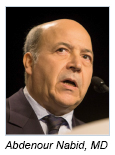Eighteen months of hormone therapy appears to be as safe and effective as 36 months when combined with radiation for patients with high-risk prostate cancer.1 Patients who received the shorter course of hormone therapy plus radiation had survival rates similar to those who received 36 months of hormones with radiation in a prospective, multicenter, randomized phase III trial reported at the 2013 Genitourinary Cancers Symposium in Orlando, Florida.
“The side effects of hormone therapy are considerable and make most patients’ lives miserable. These include the ‘castration syndrome’—hot flashes, loss of libido, and erectile dysfunction,” stated presenting author Abdenour Nabid, MD, Associate Professor, Centre Hospitalier de Universitaire de Sherbrooke in Sherbrooke, Canada.
Potential Impact
“Shorter-term hormone therapy could have a big impact on the lives of men with prostate cancer, reducing the quantity and intensity of its unpleasant side effects as well as treatment costs. We hope these results will convince doctors that they can stop hormone therapy after 1.5 years instead of 2 to 3 years,” Dr. Nabid told listeners.
Optimal duration of hormone therapy in this setting is controversial. To determine whether a shorter course would lead to outcomes comparable to those with the standard of 36 months, investigators from 10 different centers in Quebec randomly assigned 630 patients with node-negative, high-risk prostate cancer (T3-4, prostate-specific antigen [PSA] > 20 ng/mL or Gleason score > 7) to radiotherapy to the pelvic area and prostate bed plus 18 months of androgen ablation therapy vs 36 months of androgen ablation therapy (bicalutamide at 50 mg/d orally for 1 month plus goserelin [Zoladex] in a 10.8-mg subcutaneous implant every 3 months).
Demographic and disease characteristics of the study population were comparable for the two arms. Median age was 71 years, median PSA level was 16 ng/mL, and median Gleason score was 8. Most patients (59.8%) had Gleason score over 7; 39.8% had Gleason 8, and 20% had Gleason 9 and 10,” Dr. Nabid emphasized.
At a median follow-up of 77 months, mortality was similar in the two arms of the study: 22.9% in the shorter-duration hormone therapy arm vs 23.8% in the longer-duration arm. Of 147 deaths, 116 patients died of causes other than prostate cancer.
Survival Rates
At 5 years, overall survival rates were 92.1% vs 86.8% for the two arms, respectively, and 10-year survival rates were 63.6% vs 63.2%. Disease-specific survival rates at 5 years were 97.6% vs 96.4%, and 10-year disease-specific survival rates were 87.2% in both arms.
Age was the only significant factor that predicted overall survival; older patients died more rapidly (P < .001)
Dr. Nabid commented that an earlier study from the European Organisation for Research and Treatment of Cancer (EORTC)2 found that 6 months of hormone therapy resulted in inferior survival compared with 36 months. “The present study suggests that 18 months may be a threshold beyond which there is no further gain. Eighteen months does the job,” he stated.
Quality-of-life data from the study will be analyzed soon, Dr. Nabid said. ■
Disclosure: Dr. Nabid reported no potential conflicts of interest.
References
1. Nabid A, Carrier N, Martin A-G, et al: High-risk prostate cancer treated with pelvic radiotherapy and 36 versus 18 months of androgen blockage: Results of a phase III randomized study. 2013 Genitourinary Cancers Symposium. Abstract 3. Presented February 14, 2013.
2. Bolla M, de Reijke TM, Van Tienhoven G, et al: Duration of androgen suppression in the treatment of prostate cancer. N Engl J Med 360:2516-2527, 2009.


